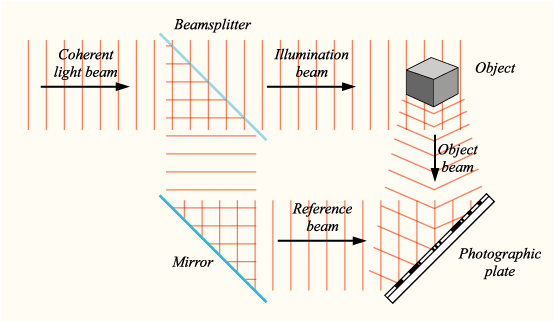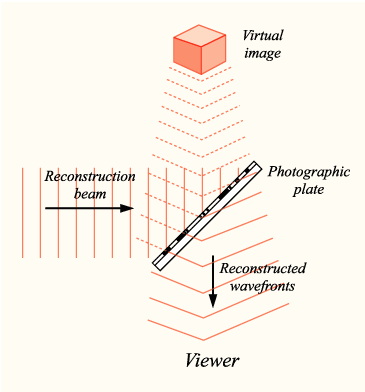Holography
|
|
Holography (from the Greek, Όλος-holos whole + γραφή-graphe writing) is the science of producing holograms, an advanced form of photography that allows an image to be recorded in three dimensions. The technique of holography can also be used to optically store and retrieve information. Holograms are common in science-fiction, most notably Star Trek, Star Wars, and Red Dwarf.
| Contents |
Overview
Holography was invented in 1947 by Hungarian physicist Dennis Gabor (1900-1979), for which he received the Nobel Prize in physics in 1971. He received patent GB685286 on the invention. The discovery was an unexpected result of research into improving electron microscopes at the British Thomson-Houston Company in Rugby, England, but the field did not really advance until the invention of the laser in 1960.
Several types of holograms can be made. The very first holograms were "transmission holograms", which were viewed by shining laser light through them. A later refinement, the "rainbow transmission" hologram allowed viewing by white light and is commonly seen today on credit cards as a security feature and on product packaging. These versions of the rainbow transmission holograms incorporate a reflective foil backing which provides the light from "behind" to reconstruct their imagery. Another kind of common hologram is the true "white-light reflection hologram" which is made in such a way that the image is reconstructed naturally using light on the same side of the hologram as the viewer.
One of the most promising recent advances in the short history of holography has been the mass production of low-cost solid-state lasers - typically used by the millions in DVD recorders and other applications, but sometimes also useful for holography. These cheap, compact, solid-state lasers can compete well with the large, expensive gas lasers previously required to make holograms, and are already helping to make holography much more accessible to low-budget researchers, artists, and dedicated hobbyists.
Technical description
The difference between holography and photography is best understood by considering what a Black & White (B&W) photograph actually is: it is a point-to-point recording of the intensity of light rays that make up an image. Each point on the photograph records just one thing, the intensity (i.e. the square of the amplitude of the electric field) of the light wave that illuminates that particular point. In the case of a colour photograph, slightly more information is recorded (in effect the image is recorded three times viewed through three different colour filters), which allows a limited reconstruction of the wavelength of the light, and thus its colour.
However, the light which makes up a real scene is not only specified by its amplitude and wavelength, but also by its phase. In a photograph, the phase of the light from the original scene is lost. In a hologram, both the amplitude and the phase of the light (usually at one particular wavelength) are recorded. When reconstructed, the resulting light field is identical to that which emanated from the original scene, giving a perfect three-dimensional image (albeit, in most cases, a monochromatic one, though colour holograms are possible).
Hologram recording process
To produce a recording of the phase of the light wave at each point in an image, holography uses a reference beam which is combined with the light from the scene or object (the object beam). Optical interference between the reference beam and the object beam, due to the superposition of the light waves, produces a series of intensity fringes that can be recorded on standard photographic film. These fringes form a type of diffraction grating on the film.
Hologram reconstruction process
Once the film is processed, if illuminated once again with the reference beam, diffraction from the fringe pattern on the film reconstructs the original object beam in both intensity and phase. Because both the phase and intensity are reproduced, the image appears three-dimensional; the viewer can move their viewpoint and see the image rotate exactly as the original object would.
Because of the need for interference between the reference and object beams, holography typically uses a laser to produce them. The light from the laser is split into two beams, one forming the reference beam, and one illuminating the object to form the object beam. A laser is used because the coherence of the beams allows interference to take place, although early holograms were made before the invention of the laser, and used other (much less convenient) coherent light sources such as mercury-arc lamps.
The coherence length of the beam determines the maximum depth the image can have. A laser will typically have a coherence length of several meters, ample for a deep hologram. Small pen laser pointers tend to have a smaller coherence length and were considered too small to do holography. That has been shown to be incorrect, and people have successfully made small holograms with laser pens. Large analogue holograms cannot be made with laser pens due to their lower power (typically 1mW to 5mW). Digital holography does not suffer from this problem.
Other applications of holograms include metrology and optical computing.
Holography in art
Salvador Dalí claims to have been the first to employ holography artistically. He was certainly the first and most notorious Catalan surrealist to do so, but the 1972 New York exhibit of Dali holograms had been preceded by "the first holographic art exhibition [which] was held at the Cranbrook Academy of Art in Michigan in 1968. The second took place at the Finch College gallery in New York in 1970 and attracted national media attention." (source: http://www.holophile.com/history.htm ). A vastly entertaining account of a 1973 Dali holography project (with Alice Cooper as subject) can be found here: http://www.alicecoopertrivia.pwp.blueyonder.co.uk/people/p-dali.php
Holographic data storage
See the main article at holographic memory.
Holography can be applied to a variety of uses other than recording images. Holographic data storage is a technique that can store information at high density inside crystals (à la HAL 9000) or photopolymers. As current storage techniques such as DVD reach the upper limit of possible data density (due to the diffraction limited size of the writing beams), holographic storage has the potential to become the next generation of storage media. The advantage of this type of data storage is that the volume of the recording media is used instead of just the surface.
Using currently available SLM's can produce about 1000 different images a second at 1024 X 1024 bit resolution. With the right type of media (probably polymers rather than something like LiNbO3), this would result in about 1 Gigabit per second writing speed. Read speeds can surpass this and experts believe 1 Terabit per second readout is possible.
In 2005, the company Optware has produced a 120 mm disc that uses holographic surface to store data to a possible 1TB (terabyte). See Holographic Versatile Disc, for more information.
External links
- Template:US patent -- "Wavefront reconstruction using a coherent reference beam" -- E. N. Leith et. al.
- An article describing how to make holograms with a laser diode (http://www.holokits.com/a-make_holograms.htm)
- Forum on amateur holography (http://www.holographyforum.org/)
- How Holographic Memory Works - http://computer.howstuffworks.com/holographic-memory.htm
- How Holographic Environments Work - http://computer.howstuffworks.com/holographic-environment.htm
- InPhase Completes World's First Holographic Drive Prototype - http://www.inphase-tech.com/news/firstholoproto.htmlbg:Холография
de:Hologramm eo:Holografio fr:Holographie he:הולוגרפיה ja:ホログラフィーnl:Holografie pl:Holografia sv:Holografith:โฮโลกราฟี zh:全息照相法


